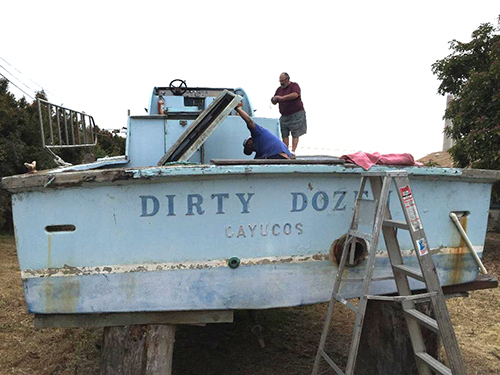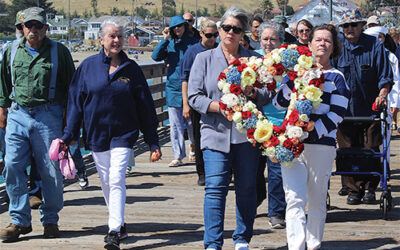Master Modeler Ken Foran Measuring Harold Biaggini’ Dirty Dozen before Demo. Finished 3-D model on display at MBMM.
Author Note: I am over-the-moon excited about the Morro Bay Maritime Museum’s (MBMM) current oral history project. I served on the board of directors during its site development and heard the group had funded over 20 hours of interviews with working commercial industry representatives. In 2001-2002 AGP Video did the camera work for interviews conducted by Steve Rebuck, a commercial fisheries consultant, and Dr. Monica Hunter, a Cultural Anthropologist. It was a dream of our board to have these videos available for the public to understand the fisherman’s perspective of life on the waterfront and out to sea. I previewed those soon to be live at www.morrobaymaritime.org and on YouTube. The hour you will spend with each person is even more enlightening than I anticipated. Many thanks for the collaboration efforts of MBMM, AGP Video, and Rock Harbor Marketing for preserving and sharing these once “buried treasures.”
Scott Mather is MBMM’s President of the Board of Directors. He and wife Lori have increased the audio-visual experiences at the museum. He said, “We are so indebted to the early founders of our association for coordinating this first person account of the industry that is our community’s legacy. We also have stories on the website by those who worked and served aboard our fleet. We intend this oral history education project for students and journalists to do their research and for residents and tourists to enjoy stories from our maritime past. It will also be a living memory for families and friends of those interviewed to see and hear individuals no longer with us.”
Born in Cayucos December 5, 1923, Harold Biagini tells the story that his Swiss-Italian grandfather sailed around the horn to Monterey and author Robert Louis Stevenson gave him twenty-five cents to survive. The Cayucos dairy family grew to seven ranches. Harold recalls riding five miles on horseback to school every other day. Other days they wagoned cream to market. “Abalone covered the rocks and we’d fish-fry on the beach.” On display is a replica of Harold’s dive boat produced by master modeler Ken Foran. Many of us enjoyed a glimpse of one of Morro Bay’s favorite citizens, Ed Biagini.
Frank Brebes, an abalone diver, would free dive as would most of the divers interviewed. Hard-hat diving was risky because one had to depend on an active crew on-board not cutting one’s air hose. He opines the days when he felt Fish and Game wardens were more of an ally for the fisherman.
Tour Avila Pier during Barry Cohen’s interview. He believes he was the area’s first commercial diver for sea urchins, a hot market for Japanese eateries in Los Angeles. Mr. Cohen candidly discusses the impact of quota regulations on the industry.
Marco Collini fished albacore. His Dad immigrated from Italy to San Diego to Alaska on the Star of India, which now is a major exhibit at the San Diego Maritime Museum. At 14 Collini was in the Galapogos Islands diving for live bait caught in the nets. At 17 he fished for swordfish in Alaska. During WWII he was asked if he wanted to be a Navy diver. After a fifteen minute dive, they said he was trained.
Tour a 2001 fish processing operation at the Old Port Fish Market on Avila Pier after Travis Evans’ interview. His teacher at Visalia High School recommended he study Animal Husbandry at Cal Poly. In 1939 he could afford the all boys’ school by working and sleeping in the dairy barn. He discusses his concerns for the future of Central Coast fisheries with pending regulations.
Joe Giannini’s animated interview brought him from Newport, OR to Morro Bay in 1946. Fishing was in its heyday and the fishermen convinced him to build Marine Service & Equipment on Market Street. There were 365 fishing boats out of Morro Bay that needed servicing. He recalls he sold out of 5-inch televisions one year since the fisherman wanted to watch the World Series at sea. Sit down with Jody Giannini, too, who took over the business.
A past president of the Morro Bay Commercial Fishermen’s Organization (MBCFO), Wayne and Diane Moody fished together for 23 years. He worked at Diablo and participated in competition sport diving for urchins and abalone. The couple discusses building and working their commercial fishing boat.
Jeremiah and Trudy O’Brien talked about fishing together, diving for urchins and gill net fishing until Jeremiah took on extra duties as the MBCFO’s spokesperson and negotiator during years of difficult times as regulations impacted the industry.
Born in 1918 Gerard Parsons is a sixth generation San Luis Obipso descendant of Jose Francisco Ortega, guide to San Diego founder Gaspar de Portola and Father Junipero Serra. Parsons was a founding father of the San Luis Obispo Yacht Club and active in the development of Port San Luis.
“…those guys were crazy” was often said about fishing partners Dean Tyler and Ernie Porter. Their interview comes with a tour of the Morro Bay Aquarium during its heyday complete with barking seals. The fishing duo had tales to tell about diving, learning to use new scuba equipment and their selvedge adventures.
Lawrence Thomas’ original plan was a shell stand to keep young son Dave busy while keeping his eyes peeled for a Hwy. 1 property to open a shell shop and entice tourists to visit Morro Bay. He talks about his property struggles over the three lots he had title for as the Tidelands harbor district was in development. He only maintained the corner Embarcadero property for a successful Shell Shop business. But before opening it he was a fisherman and tells a gripping survival story when he and the Mrs. took their newly owned small craft to Alaska to salmon fish. A major storm outside of Coos Bay almost ended more than their adventure. Once Dave took over management of the Shell Shop, Lawrence enjoyed his travels looking for rare shells.
Wilmer Tognazzini knew he wanted to be a teacher when he was eight years old. In 1935 he was principal of Morro Bay Elementary School with six classrooms. He built eight more. His students were mainly fishermen families. “No one has more integrity than a fisherman,” he maintained. He was always teaching — wandering from table to table at his son, Mark’s Tognazzini’s Dockside Restaurant talking about the lifestyle of fish the diner’s were eating. At the time of the interviews he had published fifteen books on local history from the columns he wrote for the local newspaper.
Two separate interviews were completed with Eddie and Dick Sylvester who were born and grew up in San Luis Obispo. Both worked the family tugboats for the oil industry out of Avila. Dick branched out to fishing, but stayed home the year he was married then for survival income went back to sea. He told the wife she wasn’t going to see much of him and explained to the Steve and Monica if a fisherman didn’t have an understanding wife the marriage was destined to fail.
Travis Ford wrapped it up as the project goes live, “The Maritime Museum team are remarkable stewards of Morro Bay’s maritime history. The names represented in these videos are true legacies to the very origins our city was founded on. We consider it a privilege to help them bring these interviews into the modern age of content viewing and hope that residents, visitors, and the families of those interviewed will be able to enjoy them for years to come.”



